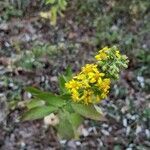Plants 40–150 cm; caudices stout, sometimes with long slender rhizomes. Stems 1–20(–50+), stout, finely puberulent or scabrous-puberulent at least distally. Leaves: basal absent at flowering; cauline sessile to short-petiolate; blades usually lanceolate-elliptic or ovate, sometimes linear-lanceolate, 30–150 × 5–30 mm, thick and firm, margins entire or few toothed, somewhat to much reduced distally, abaxial faces sometimes resinous and shiny, glabrous or strigillose (hairs mostly 0.1–1.4 mm), adaxial glabrous or scabrous. Heads 10–190+ in paniculiform (rarely racemiform) arrays, usually elongate, usually leafy-bracteate, bracts similar to distal leaves but reduced; branches stiffly ascending, not secund, sometimes elongate. Peduncles mostly 2–15 mm, bracteolate, sparsely to densely short hispid-strigose. Involucres campanulate, 4.5–7.5 mm. Phyllaries in 3–4 series, unequal, linear-lanceolate, acute to attenuate, ± squarrose-tipped, glabrous or moderately strigose, sparsely to moderately stipitate-glandular, sometimes viscid. Ray florets (5–)7–9; laminae 3–7 × 1–2 mm. Disc florets (8–)10–16; corollas 4–5 mm, lobes ca. 1–2 mm. Cypselae 3–4 mm, glabrous or glabrate; pappi ca. 4 mm. 2n = 18, 36, 54.

